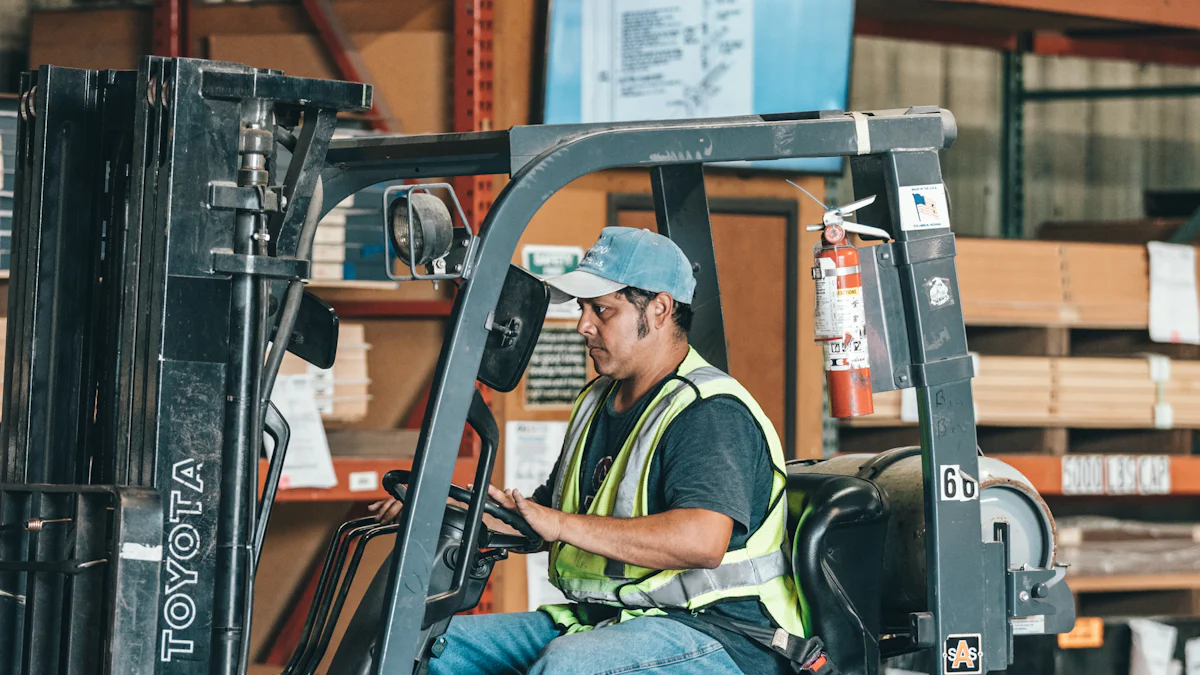
When operating a scissor pallet jack on ramps, safety is paramount to prevent accidents and injuries. According to OSHA reports from 2002-2016, there were 56 major injuries involving pallet jacks, including 25 fractures and 4 fatalities. Understanding how to safely use scissor pallet jacks on inclines can significantly reduce these risks. In this blog, we will delve into the essential guidelines for safe operation on ramps to ensure your well-being and the protection of those around you, including answering the question: can scissor pallet jacks go up a ramp?
Understanding Scissor Pallet Jacks
When it comes to handling heavy loads in warehouses or department stores, pallet jacks play a crucial role. These robust tools, also known as Scissor Pallet Trucks, provide a reliable and efficient method for transporting goods. Available in various sizes and lift capacities, they are designed to streamline the movement of products within these environments.
What are Scissor Pallet Jacks
Definition and purpose
Scissor Pallet Jacks, characterized by their scissor-like lifting mechanism, are manual handling equipment used to lift and transport palletized goods. The primary purpose of these jacks is to simplify the process of moving heavy loads across short distances. By leveraging hydraulic power, they can elevate pallets to a suitable height for transportation or storage.
Key features
- Maneuverability: Scissor Pallet Jacks are engineered with swivel wheels that enable easy navigation through narrow aisles and tight spaces.
- Durability: Constructed from sturdy materials, these jacks can withstand the rigors of daily use in industrial settings.
- Ease of Use: With user-friendly controls and ergonomic handles, operating a Scissor Pallet Jack is straightforward for warehouse personnel.
- Versatility: These jacks come in different configurations to accommodate varying load sizes and weight capacities.
Can Scissor Pallet Jacks Go Up a Ramp
Explanation of capabilities
Moving a pallet jack up an incline poses unique challenges due to the nature of its design. While traditional flat surfaces pose no issue for these jacks, ramps introduce factors like gravity and traction that affect their performance. Despite this, with proper technique and caution, it is indeed possible for Scissor Pallet Jacks to ascend ramps safely.
Safety considerations
- Weight Distribution: When ascending a ramp, ensure that the load on the pallet jack is evenly distributed to prevent instability.
- Controlled Speed: Maintain a steady pace while moving up the incline to avoid sudden movements that could lead to accidents.
- Traction Awareness: Be mindful of the surface traction on the ramp; if it’s slippery or uneven, adjust your approach accordingly.
- Assistance Requirement: Depending on the weight of the load and steepness of the ramp, having additional personnel assist you can enhance safety.
Safe Operation on Ramps

Preparing for Ramp Use
Inspecting the ramp
When examining the ramp before use, ensure that it is free from any obstructions or damages that could hinder the smooth movement of the scissor pallet jack. Look out for debris, spills, or irregularities on the surface that might pose a risk during operation. It’s essential to confirm that the ramp is structurally sound and capable of supporting both the weight of the pallet jack and the load it carries.
Checking the pallet jack
Before initiating your ascent or descent on the ramp, take a moment to inspect the scissor pallet jack thoroughly. Verify that all components are in proper working condition, including wheels, handles, and lifting mechanisms. Ensure that there are no leaks in hydraulic systems and that brakes are functional. Confirm that the load on the pallet jack is within its specified capacity limits to prevent overloading accidents.
Moving Up an Incline
Proper technique
To ascend an incline safely with a scissor pallet jack, position yourself behind it with a firm grip on the handle. Utilize controlled force to push and guide the jack up the ramp steadily. Maintain a consistent pace without sudden movements to prevent loss of traction or instability. Remember to keep your focus ahead to anticipate any obstacles or changes in surface conditions as you progress upward.
Positioning and pulling
As you begin moving up an incline, ensure that your body weight is distributed evenly behind the scissor pallet jack to maintain balance and control. Lean slightly into the handle while exerting pressure to propel it forward gradually. By positioning yourself strategically and applying steady pulling force, you can navigate inclines with confidence and precision. Remember always to prioritize safety by staying alert and responsive throughout this maneuver.
Moving Down an Incline
Proper technique
When descending a ramp with a scissor pallet jack, adopt a cautious approach by walking behind it as a stabilizing force. Control its descent by providing resistance against gravity’s pull while maintaining a safe speed. Avoid sudden braking or jerky movements that could lead to loss of control or tipping over. Keep a steady pace downward while remaining vigilant of your surroundings for optimal safety measures.
Positioning and braking
As you guide the scissor pallet jack down an incline, position yourself uphill from it to act as a counterbalance against gravitational forces. Apply gentle pressure in conjunction with controlled braking actions to regulate its speed effectively. By positioning yourself strategically above and behind the jack, you can mitigate risks associated with downhill movement and ensure smooth navigation along ramps without compromising stability or safety precautions.
Avoiding Common Hazards
Uneven floors
- Walk cautiously on uneven surfaces to maintain stability and prevent accidents.
- Inspect the floor for any irregularities that could cause the pallet jack to tip over.
- Adjust your movements accordingly to navigate safely across uneven terrain.
- Ensure a clear pathway by removing obstacles that may obstruct the smooth operation of the pallet jack.
Floor debris
- Clear any debris or obstacles from the path before proceeding with the pallet jack.
- Watch out for loose materials that could get caught in the wheels and impede movement.
- Sweep or remove debris to create a clean and safe environment for operating the pallet jack.
- Stay vigilant and proactive in identifying and addressing potential hazards posed by floor debris.
Common Mistakes and Tips

Mistakes to Avoid
Incorrect positioning
- Stand behind the scissor pallet jack when moving on ramps to maintain control and prevent accidents.
- Ensure your body weight is evenly distributed while operating the pallet jack on inclines for stability.
- Avoid positioning yourself downhill of the jack to reduce the risk of tipovers and maintain a safe distance.
- Keep a firm grip on the handle and exert controlled force when navigating ramps with the pallet jack.
- Prioritize proper alignment and balance by staying alert and focused on your movements during ramp operation.
Excessive speed
- Maintain a steady pace when ascending or descending ramps with the scissor pallet jack for safety.
- Avoid sudden movements or jerky actions that could lead to loss of control or accidents on inclines.
- Control the speed of the pallet jack by applying gradual pressure and using braking techniques effectively.
- Stay aware of your surroundings and adjust your speed accordingly to prevent mishaps during ramp use.
- Remember that maintaining a moderate speed is key to safe operation and injury prevention when handling pallet jacks on inclines.
Safety Tips
Multiple people assistance
- Collaborate with colleagues or team members to assist in moving heavy loads up ramps with scissor pallet jacks.
- Assign specific roles for each person involved in the operation to ensure coordinated movement and enhanced safety measures.
- Communicate effectively with your team to synchronize actions and avoid conflicts during ramp use with pallet jacks.
- Utilize teamwork to distribute weight evenly, navigate obstacles, and maintain stability while operating scissor pallet jacks on inclines.
- Remember that having multiple people assisting you can significantly reduce risks, improve efficiency, and promote a safer working environment.
Using powered pallet jacks
- Consider using powered pallet jacks for transporting heavy loads on ramps more efficiently than manual options.
- Evaluate the terrain, load capacity, and operational requirements before choosing between manual or powered pallet jacks for ramp use.
- Train operators thoroughly on handling powered equipment, including safety protocols, emergency procedures, and maintenance guidelines.
- Regularly inspect powered pallet jacks for any malfunctions, wear-and-tear issues, or operational concerns that may affect their performance.
- Opt for powered pallet jacks equipped with safety features like anti-slip mechanisms, emergency brakes, and ergonomic designs for enhanced user protection.
By avoiding common mistakes such as incorrect positioning and excessive speed while following safety tips like seeking multiple people assistance and using powered pallet jacks where applicable, you can ensure a secure working environment when utilizing scissor pallet jacks on ramps.
Recapping the fundamental safety guidelines is crucial for your well-being when using scissor pallet jacks on ramps. By ensuring proper weight distribution, controlled speed, and traction awareness, you can navigate inclines safely. For enhanced stability, always have multiple people assist you when moving heavy loads. Consider utilizing powered pallet jacks for efficient ramp operations. Remember, prioritizing safety measures and collaborative efforts lead to a secure working environment. Stay vigilant, follow recommended practices, and promote a culture of safety in your workplace.
Post time: Jun-17-2024
